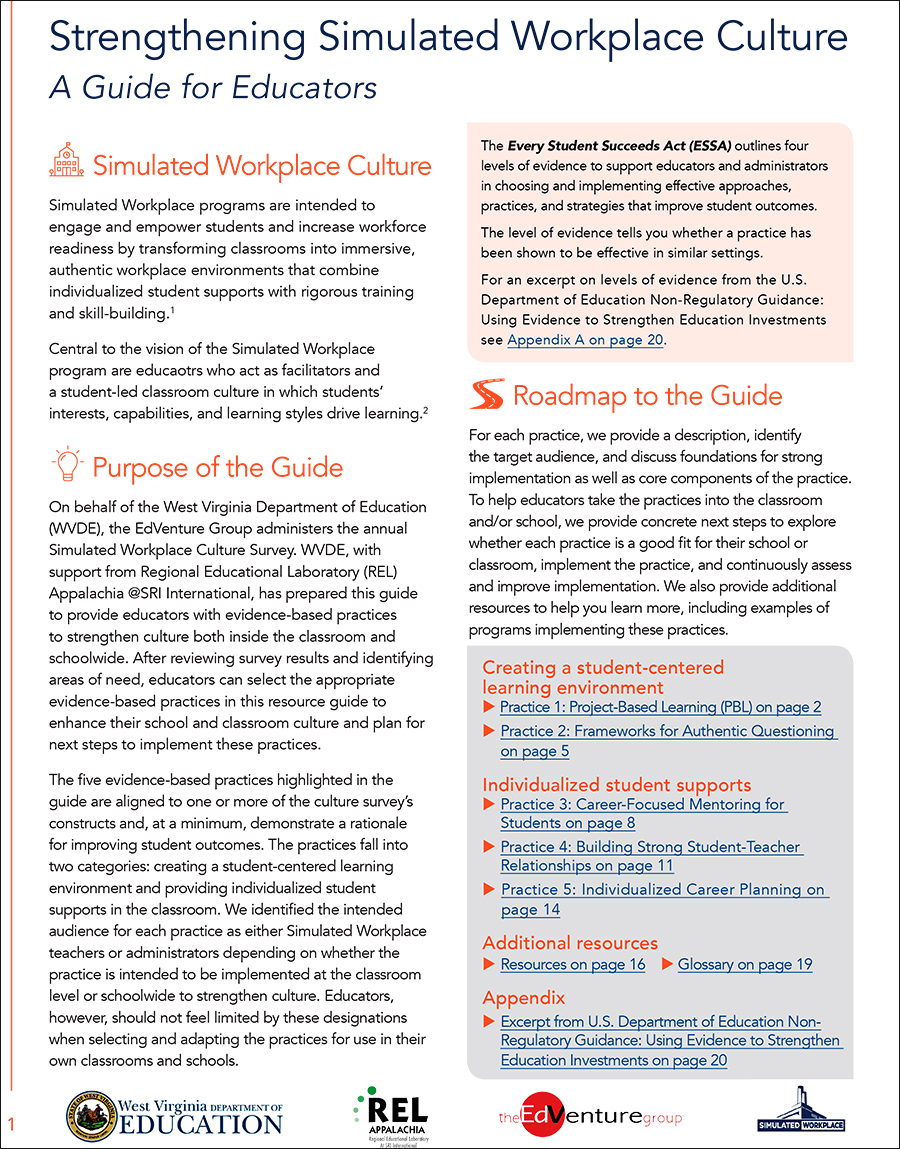by Megan Cox and Kaily Yee
April 9, 2020
(Repost of a July 31, 2019 post on the REL Appalachia Blog. REL AP serves educators in Kentucky, Tennessee, Virginia, and West Virginia to support use of data and evidence to improve academic outcomes for students.)

The 21st century economy demands an educated workforce with advanced skills and knowledge. Providing students with opportunities for high-quality, rigorous career and technical education (CTE) is receiving increasing attention across the United States.1 West Virginia’s statewide CTE program, Simulated Workplace, supports high school completion and postsecondary readiness by immersing high school students in school-based workplace environments where students establish and operate businesses to facilitate learning. Simulated Workplace enables students to have authentic work experiences (such as punching a time clock and supervising “employees” as the safety supervisor) while learning technical and 21st century skills (such as critical thinking, problem solving, collaboration, and goal setting).
Implementing Simulated Workplace requires a shift in school culture from the traditional instructor-driven classroom to a new, authentic, student-led approach that mirrors real-life work environments. Such an approach, Simulated Workplace program leaders believe, can help students learn critical skills and take ownership for their own education performance and the success of their Simulated Workplace business. In a true Simulated Workplace classroom, rather than traditional teacher-led instruction, students and teachers work together equally. Teachers do not provide solutions to problems—they become facilitators and provide guidance and resources to students. Students drive the discussions while applying project management techniques, team building skills, and problem-solving processes.
This shift from a teacher-led to a student-led classroom is not always easy, and educators need guidance on how to implement evidence-based practices that facilitate such a culture shift.
Challenges with School Culture
School culture is a set of values and beliefs and actions that make up the “persona” of the school.2 REL Appalachia (REL AP) is working with West Virginia Department of Education (WVDE) to create a more concrete connection between how students, educators, and administrators contribute to and experience school culture and practices that support six constructs of school culture: student empowerment and engagement, collaboration, goal setting, action planning, attitudes, and openness. In 2017 and 2018 the WVDE administered a culture survey to all Simulated Workplace administrators, instructors, counselors, and students to assess their perception of these six constructs of school culture. Upon reviewing the results and working to interpret them, Simulated Workplace program administrators were challenged with what to do next—how to use these results to make changes to school culture.
Strengthening Simulated Workplace Culture: A Guide for Educators
To support West Virginia Simulated Workplace educators’ use of survey results to improve school culture and help them select practices to address areas in need of improvement, REL AP provided coaching and consultation services to support WVDE and its data collection partner EdVenture Group on the development of WVDE’s school culture practices implementation guide. The guide highlights evidence-based practices aligned with the culture constructs measured in the survey and that research suggests can strengthen school culture:
- project-based learning;
- developing a framework for authentic questioning;
mentoring students; - building strong student-teacher relationships; and
- supporting individualized career planning.
The guide contains a brief definition and description of each of the five practices, including a discussion of the findings on the relationship between the practice and stronger school culture, the overarching goal of the practice, a rating of the level of evidence based on ESSA (Every Student Succeeds Act) guidelines, and the survey constructs aligned with the practice.3 The guide then outlines—in checklist form—concrete immediate steps that teachers and administrators can take to begin implementing the practice in their program, and, that research shows have potential to strengthen school culture. For educators who would like to learn more about the practices, the guide provides a list of resources and example programs that have demonstrated exemplary implementation of the practice and have a positive association with student outcomes.
REL AP plans to continue to work with WVDE partnership members to plan for and carry out coaching and technical assistance activities in West Virginia to support school personnel in using this guide and implementing the practices and strategies in schools. With ongoing support from REL AP, Simulated Workplace administrators and teachers will be able to effectively implement practices that meet their school’s unique needs and strengthen school culture.
For more information, download the implementation guide (PDF) and read about the West Virginia Simulated Workplace program.
Footnotes
1 Goldstein, D. (2017, August 10). Seeing Hope for Flagging Economy, West Virginia Revamps Vocational Track. The New York Times, p. A1. https://www.nytimes.com.
2 Peterson, K. D., & Deal, T. E. (2011). The shaping school culture fieldbook. John Wiley & Sons.
3 Additional information on the ESSA levels of evidence is available here: https://ed.gov/policy/elsec/leg/essa/ guidanceuseseinvestment.pdf .

